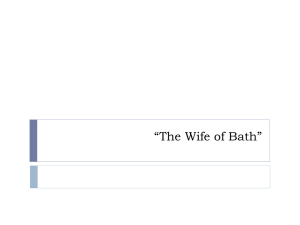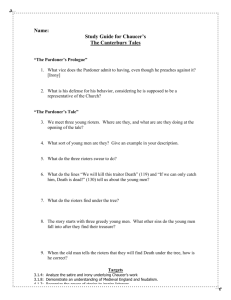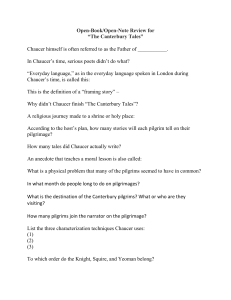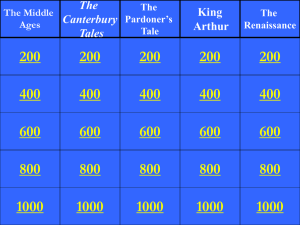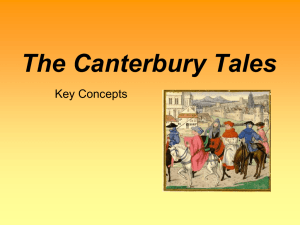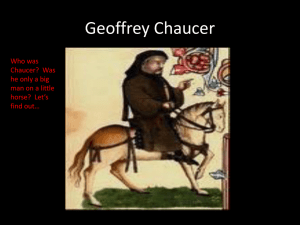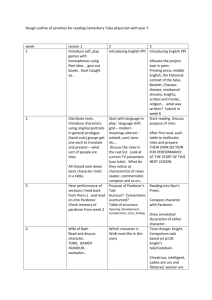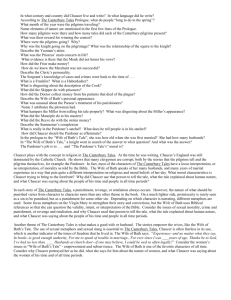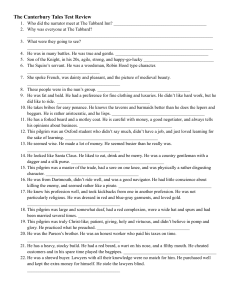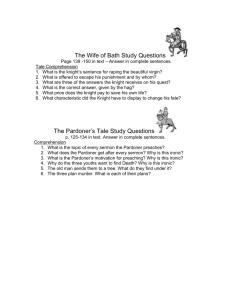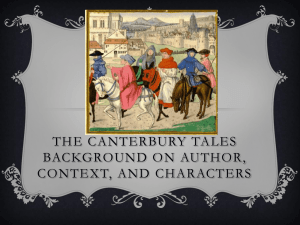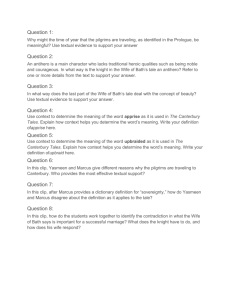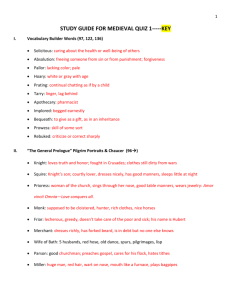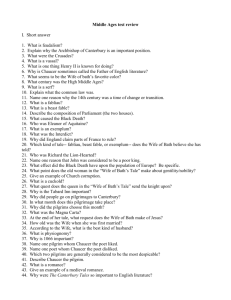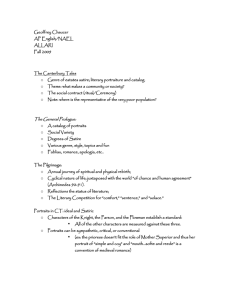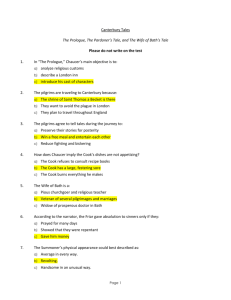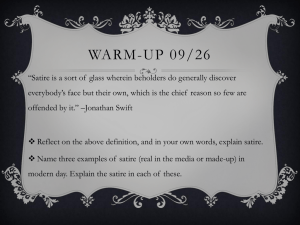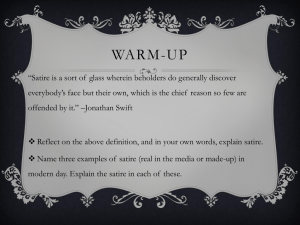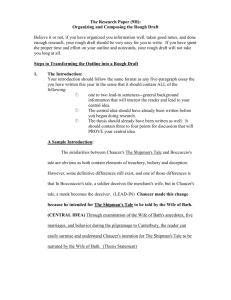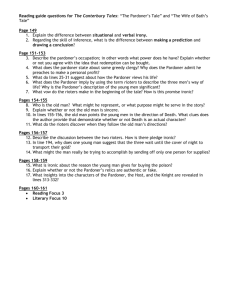Chaucer and Canterbury Tales Test Review Guide
advertisement
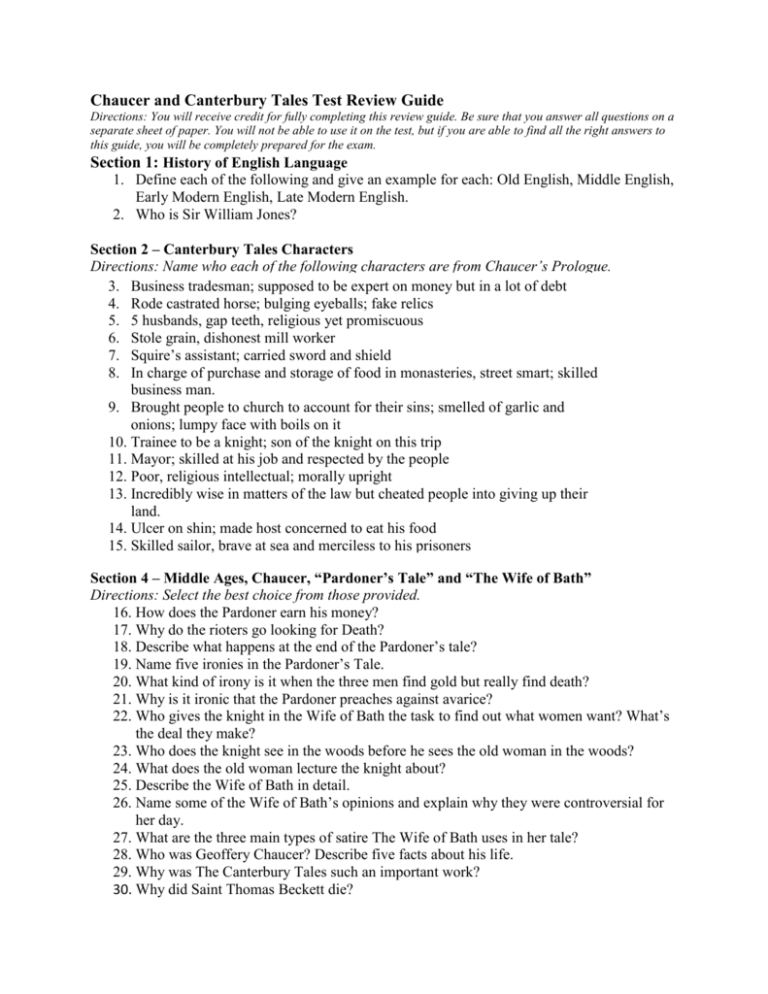
Chaucer and Canterbury Tales Test Review Guide Directions: You will receive credit for fully completing this review guide. Be sure that you answer all questions on a separate sheet of paper. You will not be able to use it on the test, but if you are able to find all the right answers to this guide, you will be completely prepared for the exam. Section 1: History of English Language 1. Define each of the following and give an example for each: Old English, Middle English, Early Modern English, Late Modern English. 2. Who is Sir William Jones? Section 2 – Canterbury Tales Characters Directions: Name who each of the following characters are from Chaucer’s Prologue. 3. Business tradesman; supposed to be expert on money but in a lot of debt 4. Rode castrated horse; bulging eyeballs; fake relics 5. 5 husbands, gap teeth, religious yet promiscuous 6. Stole grain, dishonest mill worker 7. Squire’s assistant; carried sword and shield 8. In charge of purchase and storage of food in monasteries, street smart; skilled business man. 9. Brought people to church to account for their sins; smelled of garlic and onions; lumpy face with boils on it 10. Trainee to be a knight; son of the knight on this trip 11. Mayor; skilled at his job and respected by the people 12. Poor, religious intellectual; morally upright 13. Incredibly wise in matters of the law but cheated people into giving up their land. 14. Ulcer on shin; made host concerned to eat his food 15. Skilled sailor, brave at sea and merciless to his prisoners Section 4 – Middle Ages, Chaucer, “Pardoner’s Tale” and “The Wife of Bath” Directions: Select the best choice from those provided. 16. How does the Pardoner earn his money? 17. Why do the rioters go looking for Death? 18. Describe what happens at the end of the Pardoner’s tale? 19. Name five ironies in the Pardoner’s Tale. 20. What kind of irony is it when the three men find gold but really find death? 21. Why is it ironic that the Pardoner preaches against avarice? 22. Who gives the knight in the Wife of Bath the task to find out what women want? What’s the deal they make? 23. Who does the knight see in the woods before he sees the old woman in the woods? 24. What does the old woman lecture the knight about? 25. Describe the Wife of Bath in detail. 26. Name some of the Wife of Bath’s opinions and explain why they were controversial for her day. 27. What are the three main types of satire The Wife of Bath uses in her tale? 28. Who was Geoffery Chaucer? Describe five facts about his life. 29. Why was The Canterbury Tales such an important work? 30. Why did Saint Thomas Beckett die? Section 5: Really Short Answer—Literary Devices and Techniques Directions: All of the following sentences can be completed in 1-2 words. 30. The Canterbury Tales is written with smaller stories inside of a larger one. This technique is known as… 31. The old woman in the Wife of Bath’s tale is really old and unattractive. This use of _______ adds humor to the plot. 32. The knight being corrupt and superficial is an example of ______________. 33. Light-hearted kinds of satire (like Family Guy) are known as ____________. 34. Dark, more disturbing types of satire (like 1984) are known as ____________. 35. The ABZ Children’s book that mockingly IMITATES typical kid reading material is an example of _____________. 36. A line of poetry that contains 5 stressed and 5 unstressed syllables is known as ________. 37. The Wife of Bath creates a world in which women rule over men instead of men ruling over women. In Chaucer’s day, this was most definitely an example of ____________. 38. Satire that utilizes slapstick and physical humor in order to create absurd physical situations is known as ______. An example would be someone getting hurt for the sake of humor. 39. A type of irony and satire that refers to the use of sarcasm to make a point is… Section 6: Short Answer Directions: Write a response to each of the following. Make sure you write in full sentences and that your answer is clear. 40. What is ironic about the Pardoner (of all characters) teaching such a clean, moral tale? 41. What moral does the Pardoner want us to draw from his tale? How is it different from the moral you think Chaucer wants you to draw from it? 42. Explain the views on women in the Middle Ages. Be sure to explain the complexity regarding the understanding of females at this time. How is the Wife of Bath portrayed? 43. Who is Chaucer the Poet versus Chaucer the Pilgrim? What difficulty do these two “people” pose to readers? 44. What are the two ways you can interpret The Wife of Bath?

